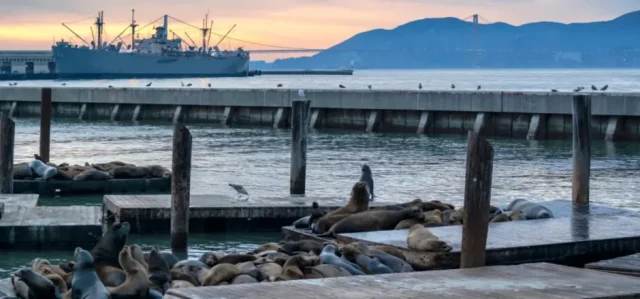California Sea Lions at Pier 39

In September of 1989 Pier 39 experienced its first sea lion visitors who started commonly appearing at the pier’s K dock. Sea lions are usually seen on Seal Rock, North of Ocean Beach, below the Cliff House Restaurant in San Francisco. Sea lions and other similar marine mammals swim into the bay to feed, sleep and rest. The K dock at Pier 39 was refurbished in 1989 and directly after this procedure boats were not allowed to dock there. This provided the sea lions with a very large resting surface. Once the boats were allowed to dock in this area the sea lions had already started using more than half of the dock. There was no effort to discourage the animals from using the dock and the fact that only half the slips were occupied encouraged more sea lions to use K dock as an alternative resting ground to Seal Rock. By the end of the year, there were between 6 and 10 sea lions seen resting on K dock.

Morning Guided San Francisco Sightseeing Tour
Most complete and entertaining San Francisco city tour available. Stops to explore Golden Gate Bridge, Palace of Fine Arts, Land’s End, and Twin Peaks.

Monterey and Carmel One Day Tour from San Francisco
This day tour hugs the scenic Pacific Coast, then offers free time to explore the Monterey’s Cannery Row and Old Fisherman’s Wharf. Relax along the 17-mile Drive to Pebble Beach and charming Carmel.
By January 1990 the number of sea lions at Pier 39 had grown to 150. As the number at Pier 39 grew the number at Seal Rock decreased. Some people speculate that the 1989 earthquake was a driving factor in the sea lions change of preferred resting ground, although this has yet to be proven. The only certainty is that Pier 39 provides a safer place to rest since sea lion predators, great white sharks and orcas, do not enter the bay. Sea lions also are more comfortable basking in the sun on K dock because the dock floats and bobs up and down with the tide. Animals on a non-moving surface would have to move depending on the tide, but the floating dock provides a surface that moves with the tide so the sea lions don’t have to.
The sea lions placed the safety of the boat owners in jeopardy as animals weighing 100 to 1000 pounds blocked the path from the pier to the boats. There were also many other reasons to consider the animals a nuisance. The noise, smell and property damage were serious problems for the residents living in close proximity to the pier. Pier 39 contacted the Marine Mammal Center for advice and information regarding the invasion of sea lions on K dock. Pier 39 was given advice regarding moving the occupants of K dock to another location and limited information about the estimated length of time the sea lions would occupy the dock. In February 1990, 250 sea lions were counted on K dock and by March that same year the dock was inhabited by 400 animals. The drastic increase in numbers caused K dock to officially close to the public and be set aside for the sea lions that same spring.
The Marine Mammal Center has created a kiosk and docent program to study the animals and educate the public. The Marine Mammal Center performs rescues of sick and injured animals as well as the education and research program. Nearly 40 injured or sick animals have been rescued by the center at Pier 39. It is now known that the population of sea lions seen on K dock increases in May and early June right before breeding season. During breeding season the sea lions travel to the Channel Islands off the coast of Santa Barbara and return north in late summer and early fall. Since 1996 there has been an increase in the numbers of sea lions occupying K dock. The highest count to date was 1,701 in November 2009.
Today the sea lions are a natural San Francisco sightseeing attraction visited by thousands of people each year. Pier 39, with the help of the Marine Mammal Center has created a partnership that will ensure the sea lions’ safety and health for years to come. For more information about the Marine Mammal Center visit their website.